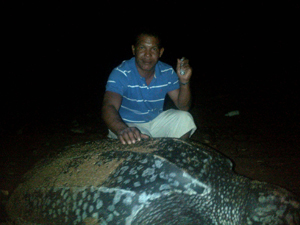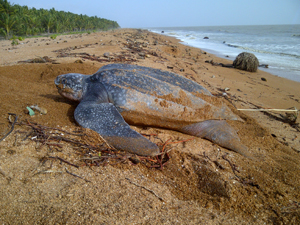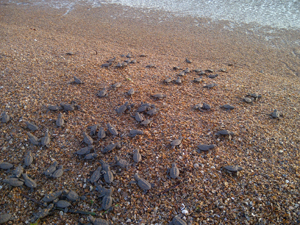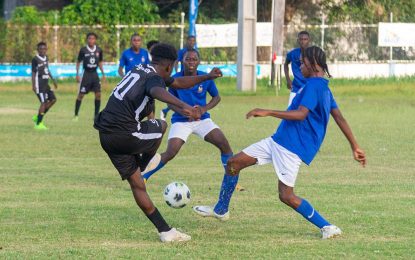Latest update November 19th, 2024 1:00 AM
Latest News
- Referendum on oil contract crucial before any future negations with Exxon-WPA
- Foreign companies making US millions in Guyana must pay fair share of taxes-says Jagdeo
- Risk of famine in Gaza has reached disaster levels’: Turkey’s President
- Woman raped and robbed in Linden
- Brutus on $16.25M bail for 231 financial crime charges
Endangered marine turtle populations increasing in Guyana
Jun 30, 2013 News
By Keeran Danny
Guyana can essentially be called a home to the Leatherback, Green, Hawksbill and Olive Ridley turtles, which are listed as critically endangered worldwide. These turtles are reportedly experiencing population growth, which is recorded and tracked. This is essentially because of the active Guyana Marine Turtle Conservation Society (GMTCS) at Shell Beach, Region One.
In a recent interview with Kaieteur News, Romeo De Freitas, Country Coordinator for Marine Turtle Project, and a person who has been involved in the conservation of marine turtle since 1988, provided greater insight into the state of the various turtle populations.
Kaieteur News (KN): What inspired the conservation of marine turtles in Guyana?
Romeo De Freitas (RD): “The Sea turtle conservation programme in Guyana, was established in 1988 by my father Audley James, who was then an active turtle hunter along with some other countrymen from the Moruca communities. The population of marine turtles in the early ‘80s was devastated, with carcases scattered all over the nesting habitat, as a result of the fact that every turtle that came to lay eggs was being killed by local fishermen and turtle hunters alike.
In 1988, my dad and Dr. Peter Pritchard, world-renowned Turtle Specialist, met on Almond Beach. Where they discussed and came up with an arrangement and methods which will enable the protection of the marine turtles. That conservation programme started in the middle of the turtle nesting season, I subsequently joined my dad on the beach at age 17 and worked along ever since.
I was inspired by my dad and this new project and generally the nesting of turtles; tagging, rescuing, relocating of eggs and releasing of hatchlings to their safety in the sea. And, at the same period trying our best to convince the turtle hunters, to stop killing the adult turtles and harvesting their eggs.”
KN: Why is so much emphasis being placed on conserving marine turtles?
RD: Sea turtles spend almost all their lives in water. But, to reproduce they need to come on land to lay their eggs. These creatures have survived the ages of the dinosaurs, but despite this they remain vulnerable. Once on the beach they are slow movers and have been targeted as prey by dogs, jaguars and humans. Hatchlings face predators such as ghost crabs, raccoons, dogs, and once entangled by nets or beach vines, they perish by the hot temperatures during the day. And finally, in the ocean they are exposed to fish, sharks, birds, nets and pollutants such as petroleum and plastic bags.
Marine turtles are a delicacy and have been used as food resources for centuries. Turtle soup has been in huge demand, especially in Europe, which relates to the overharvesting of the Greens population. Tortoise shells (scutes from the Hawksbill turtle) have also been in huge demand on the international market mainly for spectacle frames, hair slides, combs and jewels. Generally, in its entire life cycle a sea turtle faces deadly circumstances… from the time the eggs are deposited in the sand. Most beaches and coastal areas, especially on the South American Coast, have inland swamps and high tides, so whenever the rain falls and the tide level rises, a lot of turtles’ eggs are being spoiled or doom on the beaches.”
KN: What is being done to educate residents of riverine communities about the need to conserve these vulnerable creatures?
RD: In 1990 we developed an education awareness programme in Moruca and were spearheaded by Fr George Vanderwood of the Santa Rosa Roman Catholic Church and senior Teachers of the Santa Rose Primary School. We established the Santa Rosa Conservation Club, which was funded by Conservation International. The membership had consisted of over 150 youngsters, and our conservation initiative began to flourish and has continued to date.
Every year, we have groups of students from various schools – mainly from the fishing communities – visit the monitoring camps. There, we educate them on marine turtles and their environment, forestry, coastal management and protected areas.
These Education and Monitoring programmes have been funded by various entities over the years. Chelonian Research Institute (CRI), World Wildlife Fund (WWF), Eerepami and Simpson Oil Limited (SOL)
We have just completed our education awareness programme for the 2013 season, where over 100 students participated on the beach, along with teachers and parents. This initiative allows them to have a firsthand experience of the turtles. Nightly patrols with the GMTCS rangers allow them to see how the turtles are being tagged and measured, eggs are relocated, and hatchlings being released to the sea.
So generally they have a broad, practical idea of what we do. They are also exposed to the theoretical aspect, having daily indoor classroom sessions covering topics related to the sea turtles and its environment.
KN: The current state of our marine turtle populations…could you provide some perspective?
RD: In Guyana, the population of the marine turtles seems to be stable for the past few seasons; there has been an increase in Greens population for this season. The Leatherbacks have also been recorded in an increasing numbers over the past few years – due to the reproduction success of eggs being hatched over the past two decades, and marine turtles take between 25 to 35 years to mature. There is a strong and positive feeling of the outcrop of turtles nesting this season, and it generally results from our 25 years of conservation project.
From the beginning of this nesting season – early February to present date; we have recorded over 460 Greens activities and presently, the Leatherbacks started to lay their eggs at an average of eight turtles per night. One hundred and ninety-nine Leatherbacks were recorded over the past six weeks along with eight Hawksbills.
Hundreds of hatchlings have also been released and continue on a nightly basis from the hatchery.
Six dead Leatherbacks were also recorded. The cause of death was mainly because of incidental catch by long gill nets, locally known as “drift seine”. Fishing in the Nesting beach areas stills remain a problem, where turtles are being caught in gill nets and on a high percentage being drowned.
KN: Is enough being done to track the population growth?
RD: We are only concentrating in one nesting site this season, Almond Beach, which is the main nesting habitat. There are other beaches along the coast, that we could not monitor, but due to a lack of resources – both human and financial – we are forced to concentrate only on the main nesting beach.
The monitoring programme begins from February to August – annually- and data gathering is being done on a daily basis, using various methods. Analysis of the activities and records determine the population trends. These are done by the end of the season, and in comparison to the past seasons, we then get our results in terms of increased or decreased population.
Direct population of the marine turtles is not known worldwide, but in Guyana; the Greens, Leatherback and the Hawksbill are increasing, we recorded a few Olive Ridleys over the past few seasons. The Olive Ridley turtle population has been pressured by incidental catch by fishing trawlers, mainly because of their diet that consists of shrimps, sea bobs and other crustaceous.
KN: What are some of the other challenges the marine turtles encounter?
RD: Last year, we encountered over a half dozen Olive Ridleys with flotation problems. And, almost all of these turtles were rescued by fishermen in the Demerara, and Essequibo estuaries. I had kept a few turtles in captivity and treated them, until they were able to dive once more, before releasing them back to the sea. The flotation problem can be caused by turtles being hit while in foraging grounds by trawl nets, which have a special door that keeps the trawls down and expand.
Leatherback turtles worldwide are red-listed as critically endangered, likewise all the other eight types of sea turtles – but in the Guianas – Guyana, Suriname, French Guiana – and even including Trinidad, this region is known to have the largest leatherback population. In other countries such as Malaysia and Sri Lanka, the population is very low and almost gone.
Looking at it on a global perspective, Marine turtles are endangered. Of the marine turtles, Leatherbacks suffer more due to their diets – leatherbacks feed mainly on jellyfish, and on many occasions they die by suffocation as a result of consuming plastic bags instead of jellyfish.
KN: Are there protective measures in place?
RD: The Guyana Marine Turtle Conservation Society, with assistance from various agencies, has been trying to protect the marine turtles. However, it is very challenging to conserve the turtles when fishing is a major economic activity in riverine and coastal communities.
Shrimp Trawlers have a special design Turtle Excluder Devises- “TEDs” – which are being used on these trawl nets as an escaped trap door, turtles that are being caught in these nets have a fair chance of escaping, while the fish and shrimp remain in the nets. The TEDs also serve as a reducer of by catch. On the contrary, there is nothing we can do about the long gill nets and the impact they cause on the marine turtle population, other than having “No Netting Zones” demarked in front of the nesting beaches during the season.”
De Freitas indicated that because of our geographic locations and seven major rivers that flow into the Atlantic Ocean, citizens should play a more serious role and avoid discharging garbage that pollutes the waterways, because of the valuable marine stocks that depend on them as their natural habitat.
One of the future plans of the GMTCS is to encourage the Ministry of Education to include topics on the conservation of turtles and its environment (along with other endangered fauna and flora), in the school curriculum.
De Freitas also highlighted that Shell Beach is now a Protected Area and has laws that govern the protection of all endangered species. There are fines that cover the marine turtles – ranging from $70,000 to $500,000 – and imprisonment, depending on the stage of the act when being intercepted.
Share this:
- Click to print (Opens in new window)
- Click to email a link to a friend (Opens in new window)
- Click to share on Facebook (Opens in new window)
- Click to share on WhatsApp (Opens in new window)
- Click to share on Twitter (Opens in new window)
- Click to share on Pinterest (Opens in new window)
- Click to share on Pocket (Opens in new window)
- Click to share on Tumblr (Opens in new window)
- Click to share on Reddit (Opens in new window)
- Click to share on LinkedIn (Opens in new window)
Related
Similar Articles

The Glenn Lall Show | November, 18th, 2024
Follow on Tik Tok @Glennlall
THE BLUNT OF THE DAY

Sports
Nov 19, 2024
Kaieteur Sports- The Ministry of Education ground came alive on Sunday as the Republic Bank Schools’ Under-18 Football League wrapped up its fifth round of competition with thrilling...Features/Columnists
A shameful abdication of leadership
…Peeping Tom Kaieteur News- The PPPC government has reached a new low in its spineless defense of the lopsided Production... more
Rising Gun Crimes in the Caribbean: Urgent Action required by all
By Sir Ronald Sanders Kaieteur News – There is an alarming surge in gun-related violence, particularly among younger... more
Publisher’s Note
Freedom of speech is our core value at Kaieteur News. If the letter/e-mail you sent was not published, and you believe that its contents were not libellous, let us know, please contact us by phone or email.
Feel free to send us your comments and/or criticisms.
Contact: 624-6456; 225-8452; 225-8458; 225-8463; 225-8465; 225-8473 or 225-8491.
Or by Email: [email protected] / [email protected]
Weekend Cartoon

















